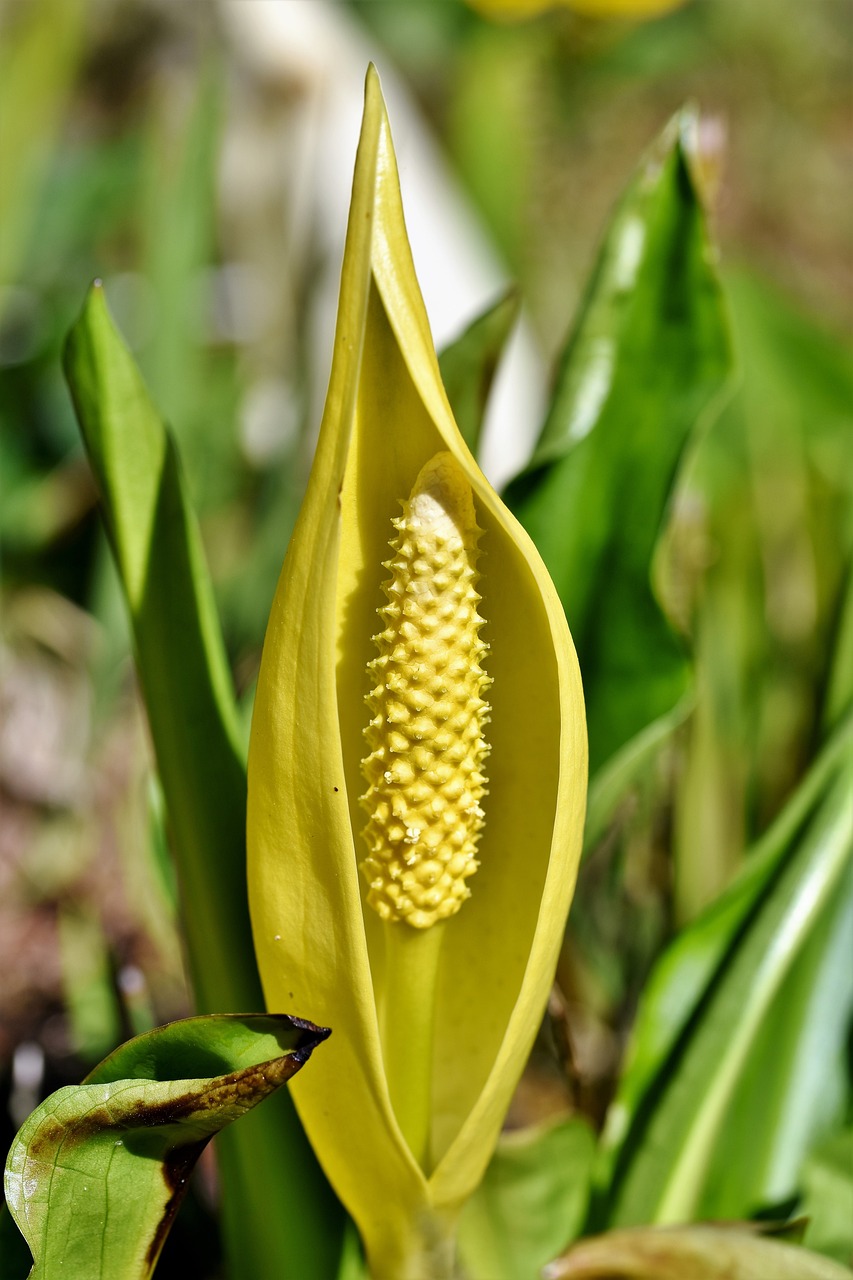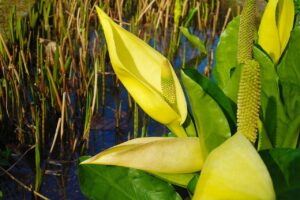Skunk Cabbage
Overview
The Skunk Cabbage, or Symplocarpus foetidus, is a wetland plant known for its large foliage and skunk-like aroma. Native to North America, it blooms in early spring with a heat-producing spadix. While historically used medicinally by Native Americans, modern applications, especially smoking, are unsupported and potentially unsafe due to toxicity concerns.
Common name(s): Eastern skunk cabbage, polecat weed, swamp cabbage, meadow cabbage, and foetid pothos.
Scientific name: Symplocarpus foetidus

Characteristics
Known for its early spring blooming, foul odor reminiscent of a skunk, and thermogenic properties.
Region
Native to the wetlands and moist hill slopes of eastern North America.
Natural Habitat
Wetlands and moist hill slopes.
Cultivation
Prefers partial shade, consistently moist or wet soil, and thrives in organic-rich, loamy soils.
Traditional Usage
Skunk cabbage has played a notable role in the traditional medicinal practices of Native Americans. While modern uses are not widely documented, understanding its historical context can provide insight into its potential applications. Here’s a brief look at how skunk cabbage was traditionally used:
- As a medicinal herb, Native Americans utilized skunk cabbage for various purposes.
- In the 19th century, skunk cabbage also appeared in the U.S. Pharmacopoeia.
- Despite being listed as a drug, detailed traditional uses during this period are not well recorded.4
- It should be noted that the plant contains calcium oxalate crystals, which are associated with medicinal properties in other plants within the Araceae family.
Given its historical medicinal value, it is important to approach skunk cabbage with both respect and caution, especially considering its potential toxicity if not used properly. It is always recommended to consult with healthcare professionals or experienced herbalists before using skunk cabbage for any health-related purposes.
Historical Usage
Used medicinally by Native Americans and listed as a drug in the 19th-century U.S. Pharmacopoeia.
Common Usage
Not commonly used in contemporary cuisine or products due to its foul odor.
Effects
The skunk cabbage is a perennial plant native to North American wetlands, recognized by its early spring bloom and the distinctly foul odor it emits, which gives the plant its name. Traditional uses and potential effects of skunk cabbage are based on anecdotal evidence and historical use by Native Americans, noting that there’s a need for scientific confirmation for any health claims.
The plant has been historically used for medicinal purposes, and while it was once listed as a drug, the specifics of its applications from those times are not well-documented. It’s important to consider that:
- The skunk cabbage is not conventionally consumed for taste due to its off-putting, skunk-like smell.
- Medicinal benefits and active compounds in skunk cabbage require further study to be substantiated.
- Calcium oxalate crystals, common in Araceae family plants, might contribute to the plant’s medicinal properties.
- There are no general effects or dosage guidelines provided for skunk cabbage.
- As with many plants, improper ingestion of skunk cabbage could be toxic.
The plant’s use should be approached with caution, and any potential medicinal application should be under the guidance of a healthcare professional or knowledgeable herbalist.

Vivid yellow spathes rise above wetland waters, hinting at potential medicinal uses yet to be fully explored by science.
Effects when smoking
When considering the effects of smoking skunk cabbage, it is essential to be aware that there is no detailed scientific evidence supporting its safety or benefits in this form. This knowledge is crucial for anyone interested in exploring the use of natural herbs for smoking.
- There is no verified information on the positive effects of smoking skunk cabbage.
- Skunk cabbage is known for its distinctive foul odor, which can be off-putting and may suggest the presence of irritating compounds.
- The plant belongs to the Araceae family, which often contains calcium oxalate crystals; these may have medicinal properties but could also be toxic if prepared improperly.
- Historically, the plant’s medicinal use was recognized, but without specific details on the method of consumption, it is unclear if smoking was ever considered or practiced.
- Given the potential for unknown health risks, any experimentation with smoking skunk cabbage should be approached with extreme caution and likely avoided altogether.
It is highly advisable to consult with a healthcare professional or a knowledgeable herbalist before using skunk cabbage or any other non-traditional herb for smoking to ensure safety and well-being.
Flavor Profile
Implied to be unpleasant, similar to its skunk-like odor.
Edible Parts
This plant is not known to be edible.
Effects when Smoked
No effects identified; smoking is not recommended due to health risks and lack of safety evidence.
User Experiences
User experiences with skunk cabbage are not documented in the provided information.
Medicinal Benefits
Skunk cabbage has a historical backdrop suggesting it may harbor medicinal properties. Native to North American wetlands, this plant was traditionally used for medicinal purposes and recognized in the U.S. Pharmacopoeia during the 19th century. Although specific active compounds and benefits are not detailed, it’s conceivable that skunk cabbage may offer certain health benefits.
However, the use of skunk cabbage, particularly for smoking, is not well-documented and could pose health risks. It is essential to conduct further scientific studies to elucidate its potential medicinal benefits. Below is a summary of its historical uses:
- It has been traditionally used by Native Americans for various medicinal purposes.
- In the 19th century, skunk cabbage was listed as a medicinal drug in the U.S. Pharmacopoeia.
Please consult with a healthcare professional or a knowledgeable herbalist before contemplating the use of skunk cabbage in any form. Given the lack of detailed scientific validation, one should approach any use of this plant with caution4.
History and Folklore
Historically, skunk cabbage has had a place in the practices of Native American medicine. It emerged as a recognized medicinal plant in the 19th century, where it appeared in the U.S. Pharmacopoeia. While the detailed applications from that era are not elaborated upon, its continued mention across centuries hints at its perceived therapeutic value. It’s important to consider that historical use does not equate to safety or efficacy, and anyone interested in its properties should consult qualified individuals before exploring its potential4.
Further adding to this plant’s historical tapestry is its absence of a detailed flavor profile, consumption methods, or user experiences within available documentation, underscoring the necessity for cautious and informed approach to its use.

Skunk cabbage: A plant with a longstanding medicinal role in Native American traditions and 19th-century pharmacopeia, yet shrouded in mystery regarding flavor and application, warranting modern caution and expert consultation.
Side Effects and Contraindications
While specific side effects of skunk cabbage are not well-documented, caution is advised due to its irritating odor which suggests the presence of potent compounds. Parts of the plant may contain substances that could be harmful or toxic when consumed incorrectly.
Contraindications:
People with known allergies or sensitivities to plants in the Araceae family should avoid skunk cabbage. Due to potential toxicity, it is particularly advised against for pregnant or breastfeeding women, and those with pre-existing health conditions should consult with a healthcare professional before use1 2 3 4.
Legal Status
The legality status of skunk cabbage is not specifically mentioned in most regulations, which suggests that it is likely not a controlled substance. As a common wetland plant, skunk cabbage does not typically fall under legal scrutiny and does not appear to have any restrictions for possession or cultivation. However, considering regional variations, it’s always best to check with local laws to ensure compliance, especially if you plan to harvest or use the plant in any form. Remember, though, that just because a plant is legal does not mean it is safe to consume or use, particularly in non-traditional ways such as smoking.
Always prioritize safety and consult with experts before using any herb.
References
1. Go Botany. “Symplocarpus foetidus – Skunk-cabbage.” Go Botany. https://gobotany.nativeplanttrust.org/species/symplocarpus/foetidus/
2. Missouri Botanical Garden. “Symplocarpus foetidus – Plant Finder.” Missouri Botanical Garden. https://www.missouribotanicalgarden.org/PlantFinder/PlantFinderDetails.aspx?taxonid=292066
3. Wikipedia. “Symplocarpus foetidus.” Wikipedia. https://en.wikipedia.org/wiki/Symplocarpus_foetidus
4. Wisconsin Horticulture. “Skunk cabbage, Symplocarpus foetidus.” Wisconsin Horticulture. https://hort.extension.wisc.edu/articles/skunk-cabbage-symplocarpus-foetidus/
Image Credit: Ralphs_Fotos
Image Credit: Scriptorium_77
Image Credit: Engel9
Nicolas Duval
Nicolas is a passionate advocate for nature and the art of wildcrafting. His dedication shines through in Wildcraftia, a website he meticulously crafted to serve as a haven for nature enthusiasts worldwide. Driven by a deep appreciation for nature’s connection to humanity, Nicolas embarked on his journey in 2011 with SmokableHerbs, a platform showcasing his love for nature’s bounty. Building upon this foundation, he established Smokably, a thriving online store offering premium herbs and blends to a global audience.
